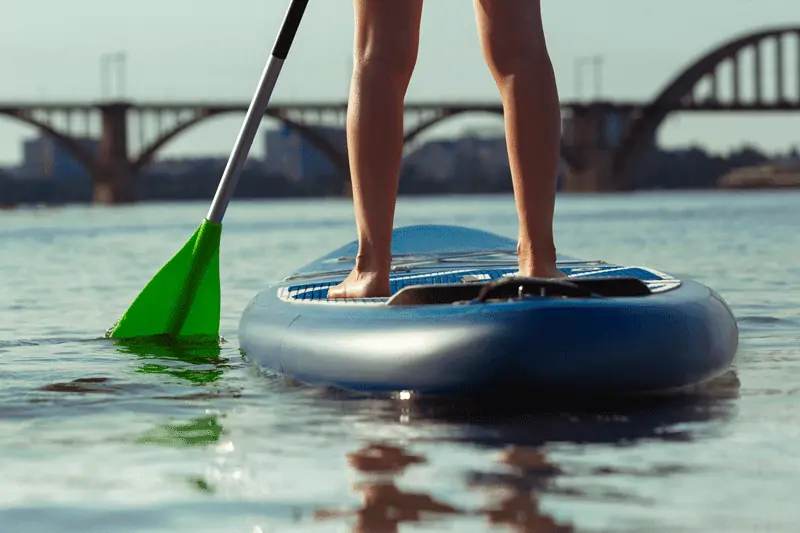When you get on a paddleboard, the thing you want to do most is not fall off. It’s easy to get thrown off balance and end up in the water.
In order to become a better paddleboarder, it is important to learn how to keep balance on the board.
There are several ways to work on your balance while on your board and off your board.
[ez-toc]

How to keep balance on paddle board?
1. The first step to the better balance while on the board is building strength in your legs. You can start this process off by doing leg exercises for about 15-20 minutes two to three times a week.
2. One way to help you get your equilibrium down is trying to stand still on the board with ease for five seconds and then try to stand still on the board with one leg and then switch.
3. Another way for you to get your balance down is by trying to kneel on the paddleboard for at least five seconds and doing this daily will help you get better at it.
4. One of the best ways to work on your balance is by trying to balance on your paddleboard with your eyes closed.
5. The next step is learning how to do a one-footed squat, landing softly with both feet being off the ground for five seconds, and then try balancing yourself with your right foot lifted off the ground for five seconds before switching legs.
6. Still standing on the paddleboard with both feet off the ground, try to do a slight squat and hold this for 15-20 seconds at least two times before trying it again daily until you are able to stand in this position.
7. The next way to improve your balance on the board is by jumping up and down from one foot to another while not touching the paddleboard with your feet.
8. Another way to practice is by kneeling on the board and starting to do a slight squat and then standing up again and repeating this process 10 times.
This will help you get more comfortable in that position and increase your endurance as well as helping you keep balance while standing on the board.
9. Lie down on the board and try to do a push-up without falling off, this will help you get better at keeping your balance while also helping you build endurance.
Practice these ways for keeping your equilibrium on the board, and you will soon be able to maintain balance and paddle around the water.
Stand right in the middle of your paddleboard
You can lean either way but you want to be centered. Then, put equal weight on both legs for about 30 seconds and then switch weights to the other leg
One thing I learned is that it’s easier to go frontwards than backward because you won’t fall as easily.
When learning how to paddle without falling off, try going forward first so you don’t have as much ground to cover if your board flips over.
When standing up on a SUP, try not to shift around too much and keep the majority of the weight in the center of your board.
If you do feel like moving back and forth or side-to-side, try doing very small jumps instead rather than unweighting one foot at a time.
That just makes it hard to stay balanced and will almost guarantee that you fall off.
If you’re having trouble staying on, move your weight back a bit and make small jumps until you feel more comfortable.
Once you start feeling comfortable, practice standing still in the center of the board with your eyes closed.
Then try doing exercises like squats and lunges while trying to balance yourself without holding onto anything else (i.e. paddle, rail, etc.) for support.”
Practice standing still on your board with both feet off the ground for at least 15 seconds before moving one foot forward or backward then trying it again with both feet off the ground.
Paddleboarding is harder than it looks, so don’t be discouraged if you can’t stand up on the board right away.
It just takes practice and patience.
Practice balance at home
Stand on one leg with your eyes closed for about three minutes.
Then switch legs.
Take it slow when you first start trying to stand up on the board, especially if it’s windy outside.
So just remember that if you’re struggling to keep your equilibrium, all it takes is a little patience and practice.
Don’t stand on your board and try to move or turn around.
It’s much harder than it looks and will just get you frustrated if you’re not used to getting off-balance.
Use a balance board to train for paddle boarding
You can use a balance board to train for paddleboarding.
A balance board is a great tool for training on a flat, stable surface.
It can teach you balance skills that translate to standing on the board and being able to walk around without falling off.
Even if you’re a skilled paddleboarder, I would recommend using a balance board to improve your skills and have more fun on the water.
To learn how to use a balance board for training, check out this guide to balance boards.
As the name suggests, balance boards allow you to practice balancing skills from all different angles, including standing on the board.
A good balance board is easy to use, fun, and can really benefit your paddleboarding skills.
10 Tips to keep your balance while on a paddleboard
- LOOK AT THE HORIZON – if you are looking down at the water, your body will naturally follow. Look up at where you want to go and lift yourself up on your legs.
- KNOW YOUR BOARD’S CENTER POINT – Balance yourself and your board by thinking of a straight line from where you stand and all the way to the tip of the nose.
- USE THOSE ARMS – Extend those arms out as if you’re about to hug someone; it’ll help keep you balanced!
- KEEP YOUR KNEES FLEXED – this is one of the biggest things that will help keep you balanced. Don’t lock your knees.
- USE BRACING STROKES – Brace strokes are always better than regular paddle strokes.
- PAY ATTENTION TO YOUR BREATHING – Breathe in when you are pushing down on the paddle for extra propulsion and breathe out when you are pulling back.
- KEEP YOUR BODY CONSTANTLY MOVING – if you’re constantly moving while on your paddle board, it’s harder to fall off.
- BE RELAXED BEFORE AND DURING YOUR TIME ON THE WATER – Stiff muscles will make it much harder to keep your balance.
- SELECT THE CORRECT PADDLEBOARD- before you get on the water, be sure to select a paddle that is right for your body size.
- PRACTICE ON-LAND BALANCING EXERCISES – before you start trying to stand or walk around on your paddle board, practice some on-land balancing exercises.
Conclusion
We hope that you found this article helpful in understanding how to stay balanced on a paddleboard.
Remember that it takes time and patience, but practicing some simple balancing exercises before you get on your board can help tremendously.
Be sure to use the 10 tips we provided for staying balanced while out paddling so that you have an enjoyable experience!
